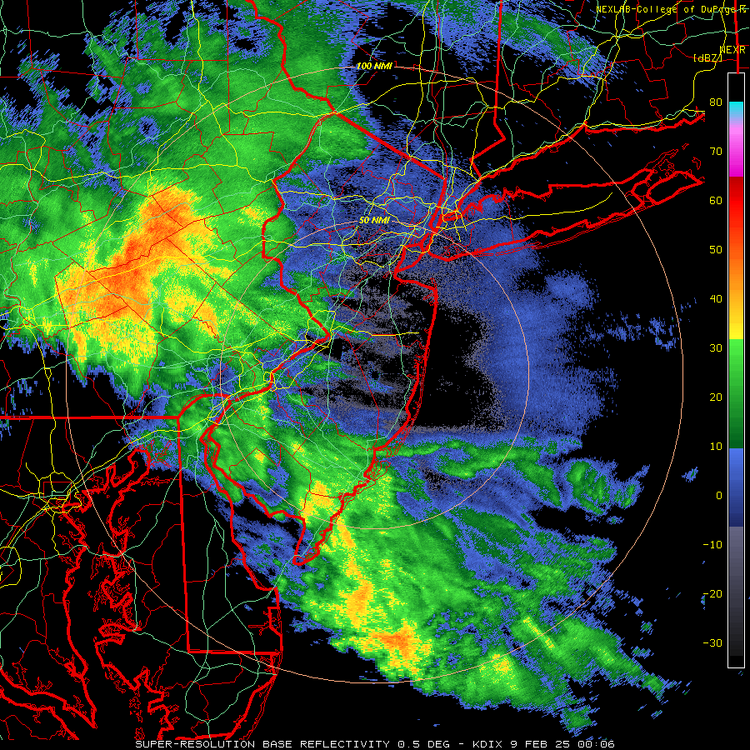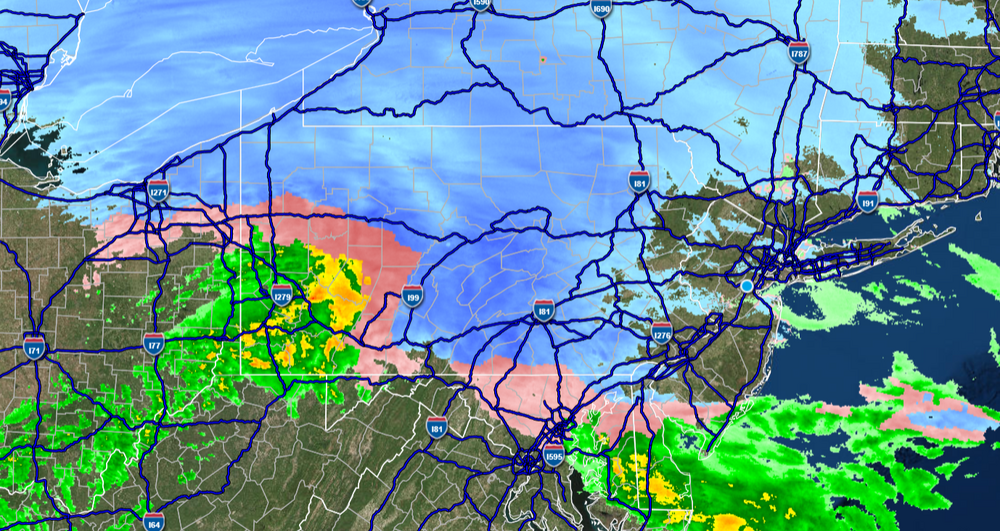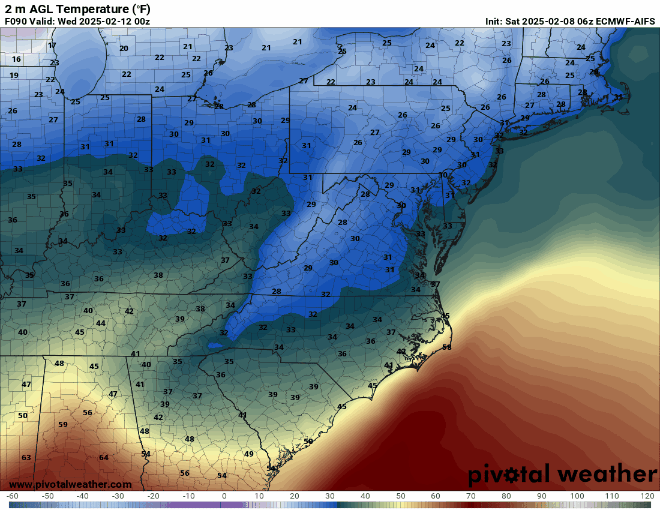
RU848789
Members-
Posts
3,759 -
Joined
-
Last visited
Content Type
Profiles
Blogs
Forums
American Weather
Media Demo
Store
Gallery
Everything posted by RU848789
-
Thanks, shouldn't have trusted the weathertap radar, lol. Dual pol shows the sleet signature pretty well in PA; as I just said in another post, my comparison was more about the precip intensity being much closer to the HRRR than the NAM, which is still a good thing at least for now.
-
Yep, just looked at that and can see the sleet signature. Also, the main part of my comparison was the radar intensity/precip looking much more robust and close to the HRRR as opposed to the NAM. There have been two "trends" that concern most - less precip on the NAM and some other models, especially W and SW of NYC and faster WAA driven transition to sleet like the NAM vs. what some of the models show. Personally, I'd rather get the higher QPF and mostly sleet than low QPF and sleet (if I can't have snow).
-
Agreed. The current radar at 6:30 pm is quite close to what the fairly snowy 21Z HRRR was showing for 7 pm pm, whereas the 18Z NAM at 7 pm looked weak and spotty. Doesn't mean the HRRR will be right and the NAM wrong, but that's the case so far, IMO.
-
Don't get me wrong, I'm very concerned about getting mostly sleet as I'd like to see some snow and the trends have not been good for mostly snow for anyone really, but the NWS knows more about this stuff than I do and I just hope they're going to be right. I'd rejoice if I got the forecast they have for me of 3.4" of pretty dense snow and sleet that comes from 0.59" of QPF, with 0.06" of ZR on top of that.
-
Also, the NWS-Philly hasn't thrown in the towel by any stretch as per their latest AFD, below. My forecast has actually had snowfall go up to 3.4" (I'm in the 3-4" swath in far northern Middlesex County. If the drier and warmer aloft-faster trends on several models verify, could be one of those storms where there's a significant difference between, say NB and places like Freehold, Trenton or Frenchtown to the S/SW/W, i.e., decently more snow and precip in NB. Maybe. Time to watch the radars and it's certainly plenty cold for snow/sleet with temps around 32F, but low humidity and dewpoints in the upper teens meaning the wet bulb effect will get most down into the mid/upper 20s for awhile. Going to be an interesting next 8 hours or so. Further north, a burst of moderate to heavy snow looks likely after sunset for the Lehigh Valley, Poconos and northern NJ, possibly extending into the northern Philly suburbs and central NJ briefly, before the change to sleet and freezing rain. Where that lingers longest as snow, highest accumulations will be found, with 3-6 inches expected in northernmost NJ, 2-4 inches in the Poconos and the rest of north-central NJ, and 1-2 inches in the Lehigh Valley, northern Philly suburbs and central NJ. This prolonged period of snow, followed by sleet, should result in less ice accumulation, closer to a tenth of an inch or less.
-
FWIW, the HRRR does jump around and has gotten a fair amount snowier, especially on the S and W margins in CNJ, over the last 4 runs. There's still hope, lol...
-
That matters a bit too, of course, but it's not April yet, so I think more than half will still be around and 90% in the shade - and I happen to live on a shady property (across from Tommy's Pond if you know Metuchen).
-
Why so low? NWS has you getting ~2" of dense snow/sleet (0.4" QPF as snow/sleet, so ~4" of snow worth), then 0.1" of ZR which will be absorbed into the pack. Do you think they're going to be that far off?
-
100% yes, assuming we get ~0.5" frozen QPF (and especially if it's mostly sleet, which melts more slowly than snow), given highs in the upper 30s Sunday and Monday and cold nights
-
Keep forgetting to post this for giggles... Last, but not least, my guess for my house in Metuchen is 1.5" of snow, then 1" of sleet (~3" of snow equivalent in that sleet) for 2.5" snow/sleet on the ground, then 0.1" of freezing rain on top. We'll see...
-
Thanks, this is great insight. Is this 1000-850 readily available? And what's it telling you for, say, my house in Metuchen - or at least in general for the 95 corridor/NYC?
-
Question if you don't mind: how much do you use the 1000-500 mbar thickness 540 line "rule of thumb" for divining the snow/rain (or mix) line? I think every model has the 540 line along/N of 84 when it's precipitating, even the snowy HRRR.
-
People need to stop with the "nil" comments from the NAM - it showed 5-6" of snow as sleet, i.e., about 2" of sleet. That's pretty damn impactful if not pretty.
-
Don - I assume the HREF is showing just pure snow correct (like Pivotal does)? Also, is this available free somewhere? TIA.
-
Found this to be interesting...hadn't noticed the snow depth before - assuming that is sleet where no "snowfall" is shown on the regular map, since Pivotal doesn't show sleet, per se.
-
6" of snow or 6" of snow as sleet, i.e., about 2" of sleet - not nothing or even close to it - still very impactful, but not as pretty. Here's the 12Z NAM for EWR - mostly sleet topped off with 0.1" of ZR. Ugly. http://coolwx.com/modelts/images/nam/current/KEWR/prec.png
-
Yes, it's really been good on tracks, plus the 6Z GFS bumped significantly back NW and the UK is a moderate hit for CNJ/NYC and SE of there where it's a big hit for Philly/SNJ. Doesn't have to shift much NW to put everyone back into at least a moderate, 2-4" event. AIFS precip is below and all of that is snow given temps are below 32F for the duration, except for SENJ. Would likely be >10:1 ratio too.
-
The updated NWS maps for snow/ice are below and show a bit of an increase in snowfall amounts for the NWS-Philly counties from Sussex down through EPA/CNJ vs. yesterday. Note that other media forecasts show more snow/sleet than the NWS (News12/TWC) and some have similar amounts (Channel 4/Channel 7; I could post them if people are interested, but I thought they were frowned upon here. Obviously a very tough forecast with 1" per hour snow (or the equivalent amount of sleet) falling over 5-6 hours, so when the changeover occurs (for those who change over) will hugely impact how much snow vs. sleet is observed; and most look to get maybe 0.1" of freezing rain at the end; also, the sleet/snow will all accumulate at night with temps generally at or below 32F for the storm. And there are models with mostly snow and little sleet vs models with mostly sleet with little snow and everything in-between so good luck to people who forecast for a living. No matter what, at the end of this storm for most in this forum, there will likely be 0.5-0.7" of frozen QPF on the ground (even the freezing rain will simply be absorbed into the snow/sleet pack) which is substantial, so impacts on driving will be significant regardless of how much snow vs. sleet and it'll be a heavy shoveling.
-
Changing the topic is a sure sign you have lost the argument. But for the record, at 1 am this morning on a model summary post I said "we're nearing consensus on a 3-5" event between 276/195 and 78" and was referring to model consensus, which was absolutely true based on last night's 0Z model runs where every single model most look at (GFS, CMC, Euro, UK, ICON, NAM and RGEM) had 3-5" for that area. It was not a forecast and I seriously questioned that model consensus this morning after seeing the 6Z and 12Z NAM showing a lot of sleet.
-
Ridiculous post since tomorrow's event hasn't started yet and its outcome is unknown. Could be a sleetfest but could also be significant snow for the City or somewhere in-between.
-
Gotcha - was just curious what you were referring to as it wasn't obvious. I was also surprised by the watch, which was pretty early.




